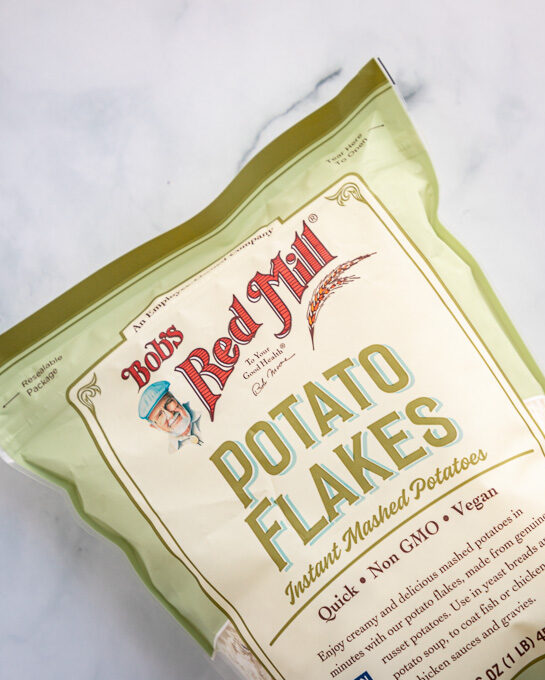The Practicable Guide to Building a Vegan Emergency Food List + Supply
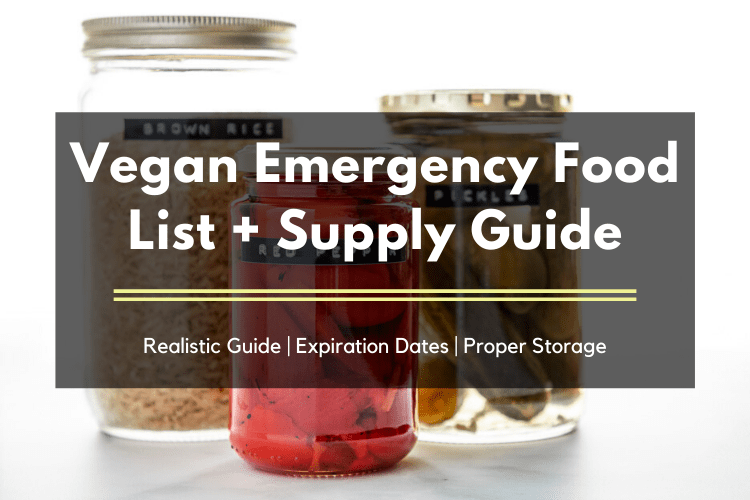
Building a vegan emergency food list and stockpile doesn’t have to be a daunting task. Learn how to build your list, decipher expiration dates, and store food for long-term storage. Stockpile like a pro with this realistic guide to the end of times.
Everything Included in this Massive Guide:
- Why Buy a Vegan Emergency Food Supply?
- My Problems With the Other “Stockpile Guides”
- A Word on Expiration Dates
- How to Start Building Your Vegan Emergency Food Supply
- Where to Buy Vegan Emergency Food Supply
- Vegan Emergency Food List:
- Where to Store Your Vegan Emergency Food Stockpile
(↑ Click to Jump)
Click to Pin the Guide for Later!
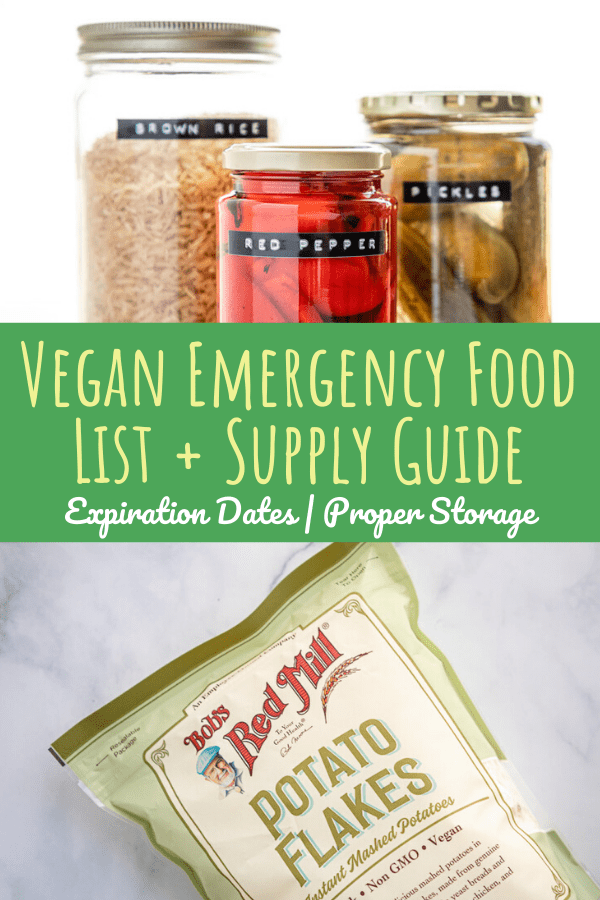
Why Buy a Vegan Emergency Food Supply?
First, for those naively wondering: “Why would I need to stockpile vegan emergency food?”
I have one thing to say:
Get with the times, sister.
Now, if this had come out sometime pre-coronavirus I’d be a bit more forgiving of the naivete.
Post Coronavirus?
It’s pretty clear why you’d need a stockpile of vegan food.
Pandemics and disasters and panic (oh my!) ramps society up to an “11”… And as we’ve seen: society quickly runs out of available essentials.
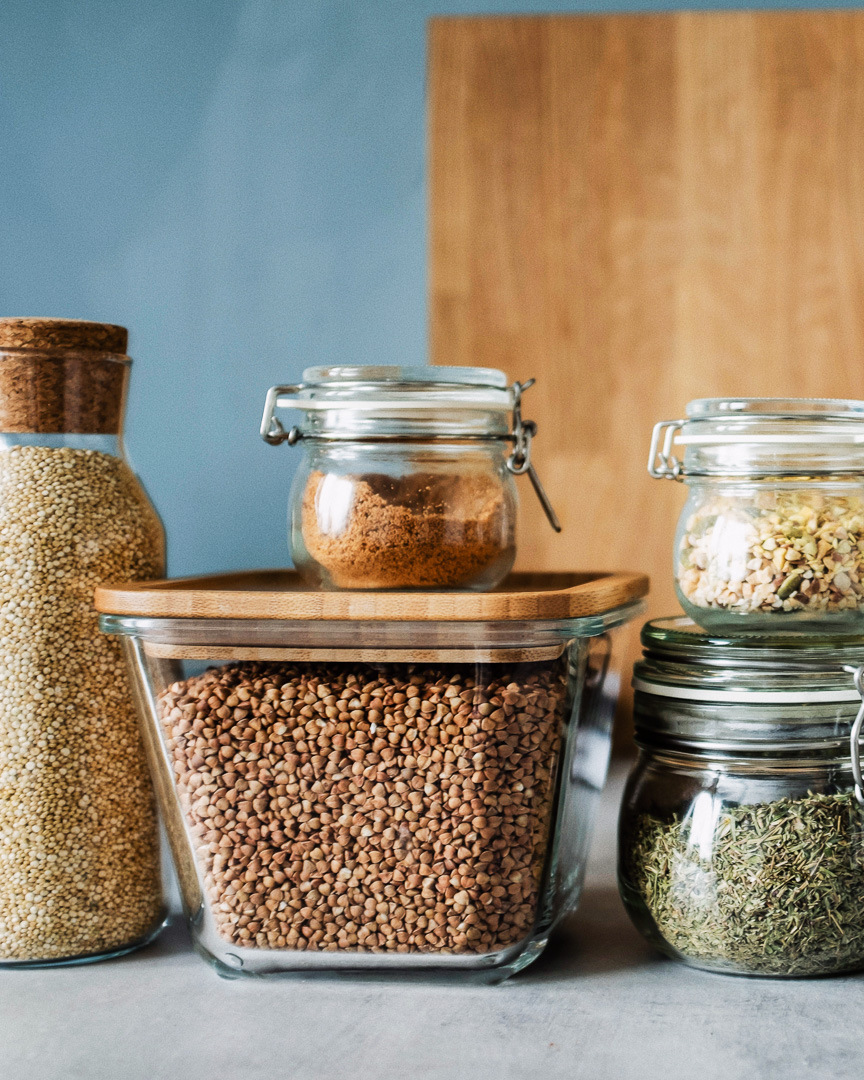
Looking Back: Emergency Food Supply Was Commonplace in My Family
Now, before we dive into this plethora of information: food storage has actually been a part of my family for generations.
In fact, some would say I was raised in a culture of food storage and emergency preparedness.
In truth, my former community was some of the most proficient stockpilers-of-food… the Mormon church.
Yes, they’ve been fear-mongering about the end of the world literally since 1830.
Do they kinda have a point about being prepared for emergencies?
Absolutely.
If truth be told:
Growing up I often stared, confusingly at the giant tins in our pantry.
“Mom, what are “dehydrated refried beans“, and why do we have 6 canisters??“
Without a second thought; she told me we had a full year’s worth of food for every member of the house… “in case something happened”.
Got it, ma’!
Especially living in Southern California at the time (and the frequent earthquakes that came along with it)… My mom ensured our food stockpile was always in tip-top shape.
Unfortunately:
After leaving the church and coming out of the closet, I fell out of food-storage practice.
Maybe all my time in the closet made me afraid to step back inside? (*wink*)
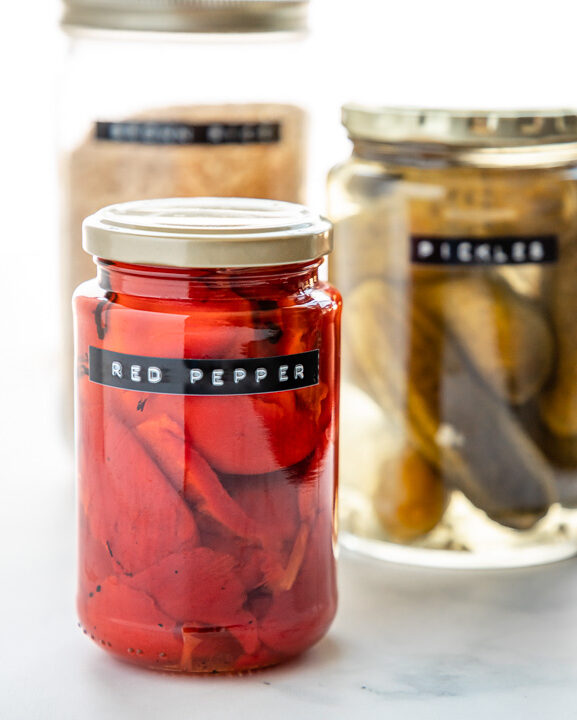
My Problems With the “Other” Vegan Stockpile Guides
The next thing you might be wondering is: “Do we really need another vegan emergency food guide?”
Well, Karen, I’m here to tell you: none of the other guides I saw were realistic.
- “Go out,
- buy a chest freezer, and
- stock it full of frozen meals”
Is not a practical or realistic option for the majority of the world.
Granted, one post did conclude by highlighting the privilege in their position… But what about the rest of us?
If you’re like me and don’t have money (or space) for a chest freezer, these guides would leave you clueless and sh*t out of luck.
Listen:
There’s a realistic and practicable way to build a vegan emergency food stockpile.
And I’m here to spill the beans (figuratively, of course… We need all the beans we can get!)
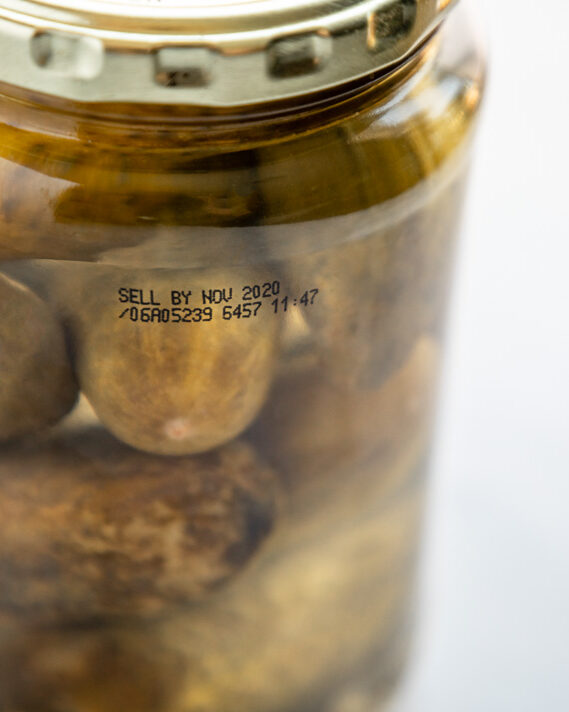
Before the List: A Word on Expiration Dates
Here’s the deal:
Canned food has an almost indefinite shelf life at moderate temperatures.
Did you think you had to go through every year, toss “expired” cans, and restock?
Surprise: you fell for a marketing ploy.
Now, I’m not saying food will last forever.
To summarize everything, we need to know the difference between these two terms:
- “Best if Used By” – Length of time food retains most of its original taste and nutrition.
- “Life-Sustaining” – Length of time foods can be stored and still be edible and will sustain life.
See the difference?
This goes past foods that simply “taste good”. We’re stockpiling food capable of sustaining life long-term.
Get it? Got it? Good!
Here’s a quick outline of some common vegan life-sustaining estimates:
| Food | “Life-Sustaining” Shelf-Life Estimates (In Years) |
| Apple Slices | 30 |
| Bakers Flour | 15 |
| Cocoa Powder | 15 |
| Cornmeal | 5 |
| Flax | 8-12 |
| Flour (white and whole wheat) | 10-20 |
| Garbanzo Beans | 15-20 |
| Gluten | 5 |
| Granola | 5 |
| Salt and Sugar | Indefinitely |
| Hulled Oats | 30 |
| Kidney Beans | 20 |
| Lentils | 20 |
| Millet | 8-12 |
| Pasta | 30 |
| Pinto Beans | 30+ |
| Potatoes (Flakes, slices, diced) | 30 |
| Quinoa | 8 |
| Rice (Brown) | 6 Months |
| Rice (White) | 25+ |
| Rolled Oats | 30 |
| Soy Beans | 8-10 |
| Sprouting Seeds | 4-5 |
| TVP | 15-20 |
| Vegetables (most) | 20-30 |
| Wheat (hard white) | 30 |
| Wheat (hard red) | 30+ |
| Yeast | 2 |
Do be aware: these estimates are assuming the food was kept properly for long-term storage. (More on that later…)
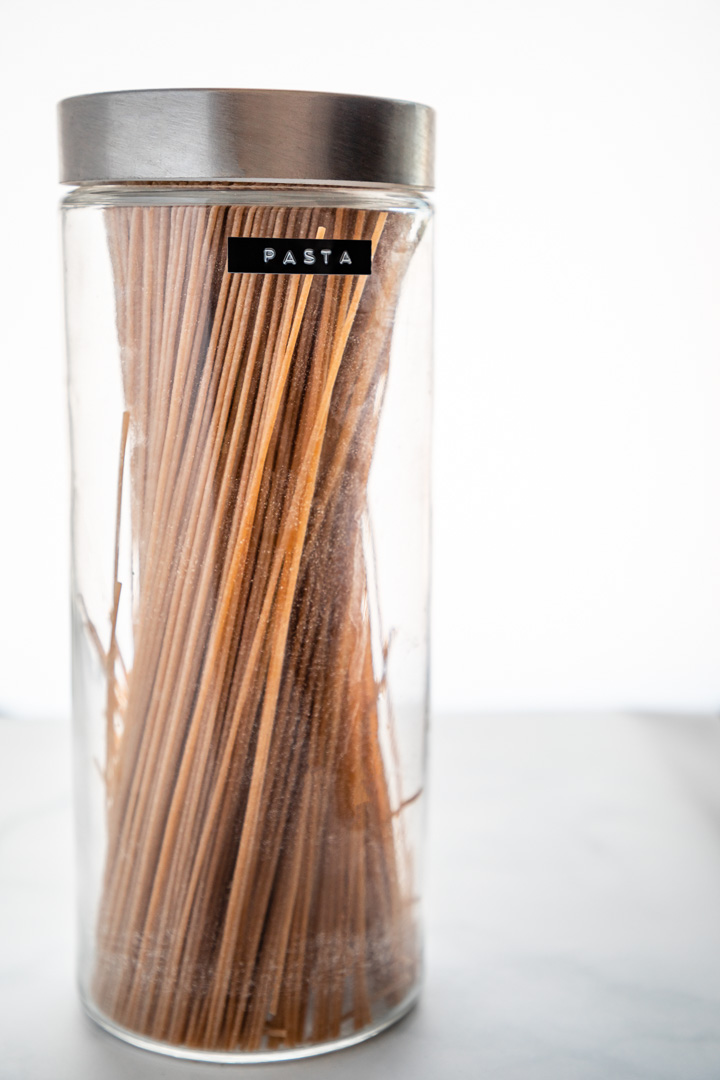
Finally: How to Start Building Your Vegan Emergency Food Supply
My realistic approach to building long-term vegan emergency food supply is simple:
- Buy enough food to feed your family for one day (either in one trip or spread out),
- Multiply that amount of food by 7 and gradually build a one-week supply
- Eventually, expand your week supply into a full month
- Even more gradually, build your month supply to three months (and beyond!)
Best of all?
Building a vegan emergency stockpile slowly helps prevent hoarding and shortages.
Even more convenient?
If you focus on the “stockpile essentials”, you’ll notice the vast majority of them are vegan staples. SCORE!
For instance:
- Wheat,
- Rice,
- Pasta,
- Oats,
- Beans,
- and Potatoes
All last 30+ years when properly stored (again: more on proper storage later).
The most important thing to remember:
Make sure the food you’re stocking up on is comprised of food you currently eat.
Why does this matter?
Drastically switching your diet can make you incredibly ill… Something you definitely don’t want during times of emergency.
Some people remedy this by periodically eating from their emergency supply… But honestly, I think this is most important for freeze-dried, franken-meals.
(Think: military MREs (Meal, Ready to Eat))
Rather than worrying, I simply stocked up on foods I already consume daily.
We’re talkin’:
- Oats,
- Beans,
- Rice,
- Etc
You know; the vegan staples.
Why Should You Eat Through Your Supply?
Now, it’s not always a bad idea to slowly chip away at your supply.
Eating the oldest food in your emergency vegan food supply can actually prevent spoilage!
Just remember to restock the next time you’re out shopping.
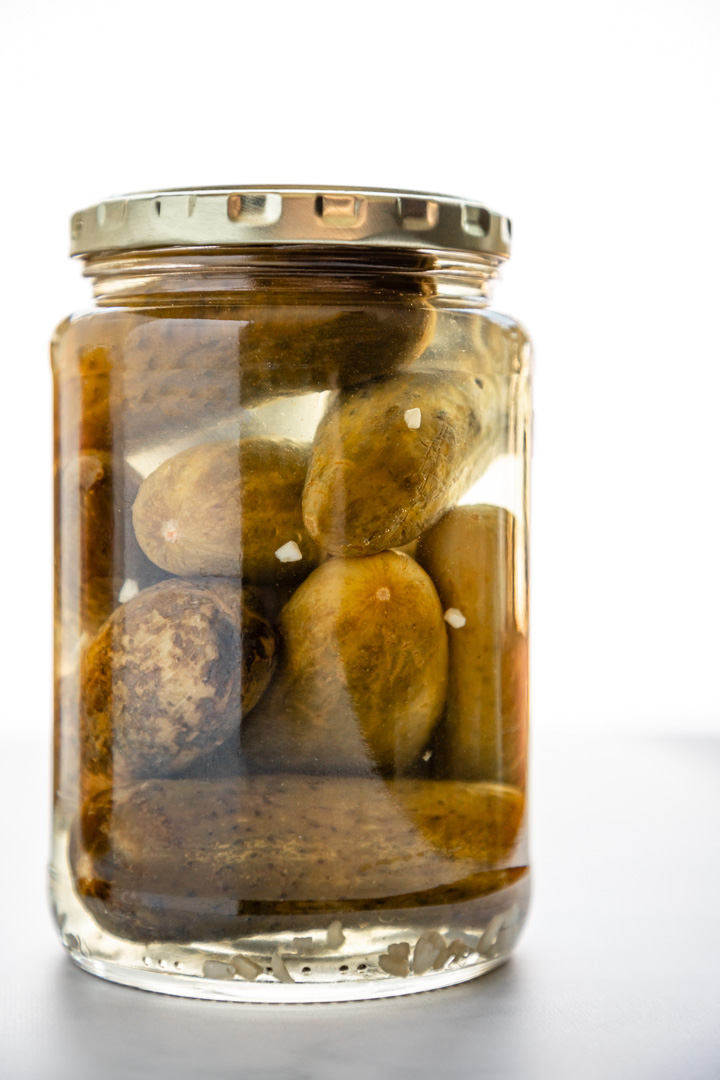
Where to Buy Vegan Emergency Food Supply
All these vegan emergency essentials are available at your favorite grocery store… Or simply click the links provided to buy online!
Most importantly: I also have a special deal for new Thrive Market members! Click here to see their selection.
That said, bulk stores (like Costco) are the perfect place to get large amounts of vegan essentials.
Even better, some have pre-made emergency food tubs that are stored and sealed for long-term storage.
Win-win!
Here It Is: The Ultimate Vegan Emergency Food List:
Canned + Jarred Goods
- Beans
- Vegetables
- Fruit (Look for low/no-sugar-added)
- Jackfruit
- Coconut Milk
- Tomato Products
Boxed + Canned Meals
Bulk Pantry Essentials
- Cereal
- Dehydrated Soup Vegetable Mixes
- Dried and Freeze-Dried Fruit
- Dried Beans and Lentils
- Granola
- Greens Powder
- Instant Potatoes
- Instant Refried Beans
- Nut and Seed Butter
- Oats
- Oil
- Pancake Mix (Store-bought or Homemade)
- Pasta
- Peanut Butter (or powdered)
- Protein Bars
- Protein Powder
- Powdered Non-dairy Milk (Coconut, Soy, etc)
- Rice
- TVP
- Vinegar (White and Apple Cider)
Baking Ingredients
- Baking Powder and Soda
- Chocolate Chips
- Cocoa Powder
- Flour (All-Purpose, Bread, and Whole Wheat)
- Powdered Egg Replacer
- Sugar
- Yeast
Shelf-Stable Liquids
Herbs + Seasonings
Non-Refrigerated Produce
Frozen Vegan Food
Vegan Food That Can Be Frozen
Tools + Other Essentials
- Can Opener
- Chef’s Knife
- Cutlery and Utensils
- Knife Sharpener
- Plates and Bowls / Eatery
- Pots and Pans
- Scissors
- Strainer
- Swiss Army Knife
Pets
Babies + Kids
First Aid Kit
- Antibacterial Ointment
- Antiseptic Wipes
- Band-Aids
- Cloth Tape
- Cold Pack
- Electrolyte Tablets
- Face Mask
- Family’s Medication
- Gauze
- Gloves
- Hand Sanitizer
- Pain Reliever
- Supplements
- Thermometer
- Tweezers
- Vegan Multivitamins
Additional, Non-Food Supplies
- Batteries
- Battery Pack
- Blankets
- Everyday Toiletries (Shampoo, soap, lotion, etc.)
- Flashlights
- Laundry Detergent
- Matches and Lighters
- Paper Towels
- Radio
- Safe, Non-Toxic Cleaning Supplies
- Solar and/or Hand-Crank Lantern
- Toilet Paper
- Water Purifier
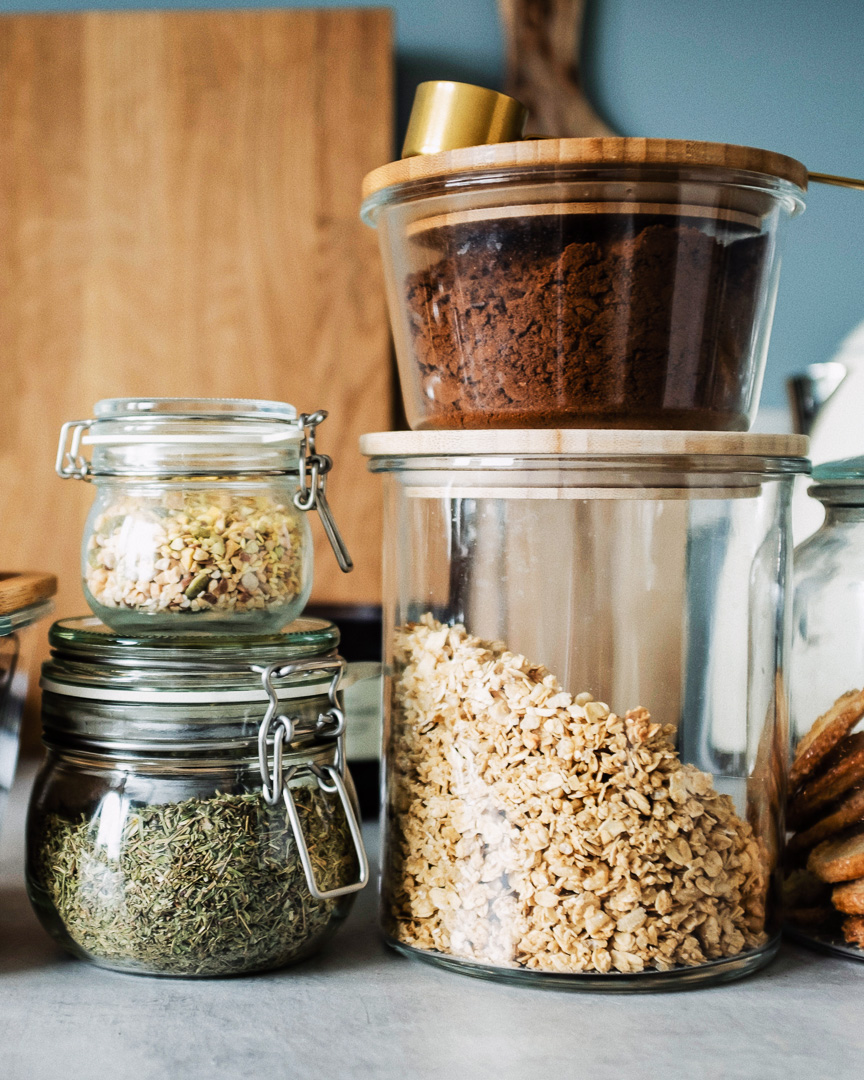
Where and How to Store Your Vegan Emergency Food Stockpile
We mentioned it time and time again… Finally, the time has come:
Let’s talk about how to properly store your vegan emergency food stockpile.
In short, the longevity of your vegan emergency food stockpile comes down to four main factors:
- Temperature,
- Moisture,
- Oxygen, and
- Light
Temperature
In short, heat destroys food and its nutritional value… Something you definitely don’t want in an emergency.
What can you do?
- If you can, keep food in the optimal temperature range of 50-60°F (10-15.5°C).
- If that’s not possible, aim for below 75°F (24°C).
Moisture
Ever wondered why long-term food storage is dehydrated or freeze-dried?
Moisture is detrimental to food storage, and in the worst cases can make you seriously ill.
What can you do?
Ensure the foods you store are completely dried and properly sealed to keep moisture at bay.
Oxygen
This may come as a surprise, but oxygen is also terrible for long-term food storage.
The last thing you want is microorganisms getting to your food before you even crack it open!
What can you do?
Serious preppers use those “Do Not Eat” oxygen absorbers in their containers.
These can luckily be found for cheap on Amazon. Read more about oxygen absorbers and food storage here.
Light
Light exposure is the last thing we have to worry about deteriorating our food.
This can cause minor problems like color changes, or more seriously: a loss of life-sustaining nutrients.
What can you do?
Keep long-term food storage in a low-light area for the longest shelf life. Using darker containers can also assist with the light issue.
So, Where Do I Keep My Vegan Emergency Food Stockpile?
This would be a good time to mention: our food storage was for a 6-person family… Which is, obviously, going to be a bit more if there’s just a couple of you.
That being said: our food storage was whenever it could (or needed to) be.
For us, this meant:
- That awkward, under-the-stairs closet
- The top shelf of our kitchen pantry
- That one “junk cupboard” that needed to be cleaned out a year ago
Other Tips for Maintaining your Vegan Emergency Food Supply
- Obviously, and it goes without saying: you want to maintain a rodent and pest-free environment to protect your supply
- Dented, rusted, or otherwise misshapen cans are a no-go
- It’s a smart idea to keep a master list of everything you have in your supply
- Make note of quantity, storage location, date of purchase, etc.,
- Print a couple of (preferably laminated) copies, and
- Store in multiple, safe locations
- (Added bonus: now you know what’s oldest and should be eaten as you cycle through it)
To Summarize The Ultimate Guide to Building a Vegan Emergency Food Supply
Don’t wait for the next world pandemic… Start building your vegan emergency food supply now.
- Plan beforehand,
- Help prevent panic,
- Don’t contribute to the hoarding, and (ultimately):
- You won’t need to clear out a whole shelf to protect your family in an emergency.
We have to come together to help protect the most vulnerable in our communities.

